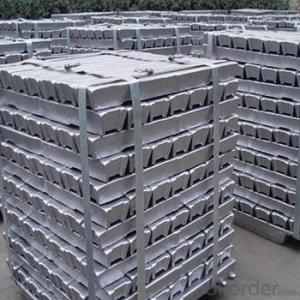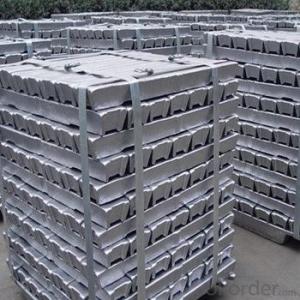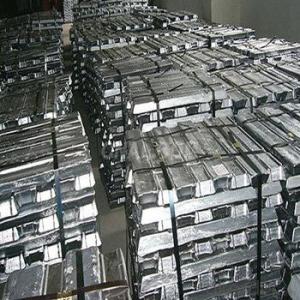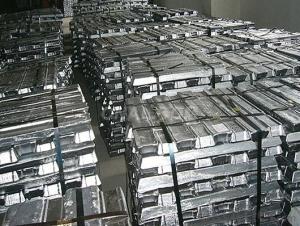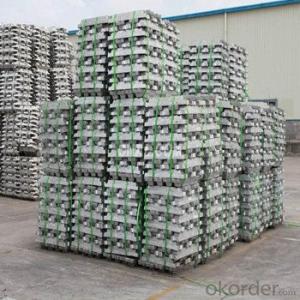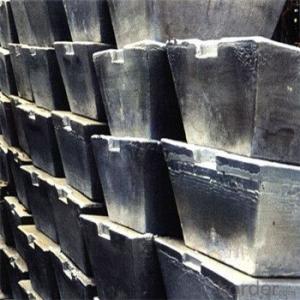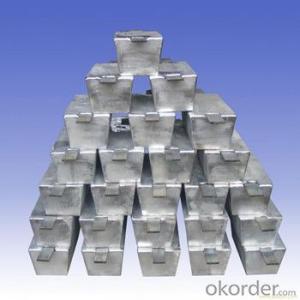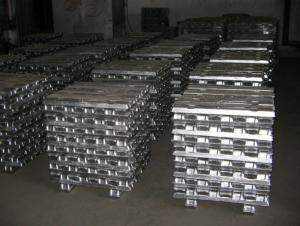Aluminum Pig/Ingot With High Purity 99.7%
- Loading Port:
- China main port
- Payment Terms:
- TT OR LC
- Min Order Qty:
- 1000 m.t.
- Supply Capability:
- 100000 m.t./month
OKorder Service Pledge
OKorder Financial Service
You Might Also Like
Pure Aluminum Pig/Ingot Used for Industry
1.Structure of Aluminum Pig/Ingot
A material that has been cast into a shape in order to be transported and processed easier than in an unprocessed form. An ingot is typically rectangular in shape, which allows it to be stacked. Ingots are most commonly associated with metals, with ingots of gold held in the vaults of banks and brokerages being popular images.
Aluminum Ingot is with the AL as the main chemical composition.Aluminum Ingot is used for industry,such as automobile,pinning and weaving,electron broadly and so on. Aluminum Ingot has the following advantages: easy control and operation, fast melting.
2.Main Features of the Aluminum Pig/Ingot
•High Purity
•Easy control and operation
•High strength
•Fast melting
•Competitive price
•Best Service
3.Aluminum Pig/Ingot Images


4.Aluminum Pig/Ingot Specification
Grade | Chemical Composition % | |||||||||
Al≥ | impurities ≤ | |||||||||
Si | Fe | Cu | Ga | Mg | Zn | Mn | others | Sum | ||
Al99.9 | 99.90 | 0.50 | 0.07 | 0.005 | 0.02 | 0.01 | 0.025 | - | 0.010 | 0.10 |
Al99.85 | 99.85 | 0.80 | 0.12 | 0.005 | 0.03 | 0.02 | 0.030 | - | 0.015 | 0.15 |
Al99.7 | 99.70 | 0.10 | 0.20 | 0.010 | 0.03 | 0.02 | 0.030 | - | 0.030 | 0.30 |
Al99.6 | 99.60 | 0.16 | 0.25 | 0.010 | 0.03 | 0.03 | 0.030 | - | 0.030 | 0.40 |
Al99.5 | 99.50 | 0.22 | 0.30 | 0.020 | 0.03 | 0.05 | 0.050 | - | 0.030 | 0.50 |
Al99.00 | 99.00 | 0.42 | 0.50 | 0.020 | 0.03 | 0.05 | 0.050 | - | 0.050 | 1.00 |
5.FAQ of Aluminum Pig/Ingot
We have organized several common questions for our clients,may help you sincerely:
①How about your company?
A big and famous and professional manufacturer & supplier of Aluminum Pig/Ingot, is one of the one of the large-scale professional investment Aluminum Pig/Ingot production bases in China.It have focuses on producing the Aluminum Pig/Ingot production for many years and gotten rich experience.Annually lagrge amount of Aluminum Pig/Ingot production are exported to markets in Europe,America and Japan. The quality and service have also gotten OEM service is available according to customer’s requirements.
②How to guarantee the quality of the products?
We have established the international advanced quality management system,every link from raw material to final product we have strict quality test;We resolutely put an end to unqualified products flowing into the market. At the same time, we will provide necessary follow-up service assurance.
③How long can we receive the product after purchase?
In the purchase of product within three working days, We will arrange the factory delivery as soon as possible. The pecific time of receiving is related to the state and position of customers.Commonly 7 to 10 working days can be served.
- Q:What are the different recycling methods for aluminum ingots?
- Aluminum ingots can be recycled through several methods, each with their own advantages and applications. One commonly used method is mechanical recycling, also known as shredding and melting. This process involves shredding the aluminum ingots into small pieces and then melting them in a furnace. The molten aluminum is then cast into new ingots or other forms for reuse. Mechanical recycling is highly efficient and can be applied to a wide range of aluminum products, including cans, automotive parts, and building materials. Another approach is smelting, which utilizes a high-temperature furnace to separate aluminum from other materials. The aluminum is melted and refined to eliminate impurities before being cast into ingots. Smelting is often employed for recycling aluminum from industrial waste, such as scrap metal or manufacturing byproducts. Chemical recycling is another method that involves breaking down aluminum into its basic components using chemical reactions. This technique is particularly useful for recycling aluminum from complex products, such as electronic waste or composite materials. The broken-down aluminum can then be used to produce new ingots or other aluminum products. Lastly, electrolysis is a method that employs an electric current to separate aluminum from its oxide form. Although this process is energy-intensive, it can be highly efficient in recycling aluminum from specific sources, such as aluminum dross or smelter slag. Electrolysis is commonly utilized in the aluminum industry to create high-quality ingots with specific characteristics. In conclusion, these various recycling methods for aluminum ingots offer multiple benefits, including reducing the demand for new aluminum, conserving energy, and minimizing environmental impact. By selecting the appropriate recycling method based on the type of aluminum waste, we can ensure a more sustainable and circular economy for this valuable resource.
- Q:What are the different forging techniques for aluminum ingots?
- Some of the different forging techniques for aluminum ingots include open-die forging, closed-die forging, and ring rolling. In open-die forging, the aluminum ingot is placed between two flat dies and compressed to shape it. Closed-die forging involves using shaped dies to create intricate and precise shapes. Ring rolling is a specialized technique where the ingot is rolled into a ring shape using radial and axial forces. These techniques allow for the production of a wide range of aluminum products with varying shapes and sizes.
- Q:What are the advantages of using aluminum ingots in the production of packaging materials?
- There are several advantages of using aluminum ingots in the production of packaging materials. Firstly, aluminum is lightweight yet sturdy, making it an ideal choice for packaging materials as it ensures easy handling and transportation while providing protection to the contents inside. Secondly, aluminum is a highly malleable metal, allowing for flexibility in design and customization of packaging shapes and sizes according to specific requirements. Additionally, aluminum is corrosion-resistant, ensuring the durability and longevity of packaging materials, even in harsh environments. Furthermore, aluminum has excellent barrier properties, effectively protecting the packaged goods from moisture, oxygen, and other external factors that could potentially degrade the product quality. Lastly, aluminum is a sustainable material, as it is easily recyclable without losing its properties, contributing to the circular economy and reducing the environmental impact of packaging waste.
- Q:What is the aluminum ingot smelting
- Concrete method: heating to melt state, through a variety of physical and chemical methods, last year after impurities, made of various grades of aluminum, pouring into aluminum ingot.
- Q:What are the different cutting techniques for aluminum ingots?
- There are several different cutting techniques for aluminum ingots, including bandsaw cutting, plasma cutting, laser cutting, and waterjet cutting. Each technique offers its own advantages and is chosen based on factors such as the desired precision, speed, and cost-effectiveness of the cutting process.
- Q:The mold is aluminum magnesium ingot foundry made it
- This mold is relatively rough, most of the manufacturing method of foundry casting and aluminum casting machine with the groove, the demand is higher, but the process is relatively complex, which belongs to the casting technology of the primary stage, is very simple.
- Q:How are aluminum ingots used in the production of appliances?
- Appliances heavily rely on aluminum ingots for their production, thanks to the unique properties and characteristics they possess. These ingots are mainly utilized in the manufacturing process to fabricate the outer casings, frames, and components of various appliances. The lightweight nature of aluminum ingots is one of the primary reasons for their utilization. Aluminum is renowned for its lightness, making it an excellent choice for appliances where weight reduction is crucial. This quality enables manufacturers to design and produce appliances that are easier to handle, transport, and install. Moreover, aluminum ingots exhibit exceptional resistance to corrosion, a vital trait for appliances that may come into contact with water or other corrosive substances. This characteristic ensures the durability and longevity of appliances, allowing them to maintain their functionality and appearance over time. Another advantage of utilizing aluminum ingots lies in their high thermal conductivity. This property enables appliances to effectively distribute and dissipate heat, resulting in increased energy efficiency and reduced risk of overheating. This is particularly significant for appliances like refrigerators, air conditioners, and cooktops. Furthermore, aluminum ingots possess high malleability, making it easy to mold and shape them into various sizes and forms. This feature allows manufacturers to create intricate designs and customize the appearance of appliances based on consumer preferences. It also facilitates the integration of different components, such as handles, hinges, and buttons, into the structure of the appliances. Additionally, aluminum ingots are recyclable, making them an environmentally friendly option. The recycling process requires significantly less energy compared to primary aluminum production, thus reducing the carbon footprint associated with appliance manufacturing. In conclusion, the extensive use of aluminum ingots in appliance production is attributed to their lightweight nature, corrosion resistance, high thermal conductivity, malleability, and recyclability. These properties contribute to the creation of durable, energy-efficient, aesthetically pleasing, and environmentally friendly appliances.
- Q:How much does it cost to process the aluminum ingots into T5-6063 models? Now, what about costing the aluminum ingot or the aluminum bar?
- T6 is artificially aged by solid solution heat treatmentIt is suitable for the products which are treated by solid solution heat treatment, no longer cold processing (can be straightened and leveling, but does not affect the mechanical performance limit)
- Q:What are the basic equipments for the production of aluminium ingots?
- If you want to match the very homogeneous ingot aluminum melting furnace, automatic machine, automatic folding spindle machine, environmental protection equipment, forklift, spectrum analyzer, loadometer, refining machine etc..
- Q:Wall aluminum window price
- Now there are all aluminum furniture, aluminum materials, for more information, you can point me
1. Manufacturer Overview |
|
|---|---|
| Location | |
| Year Established | |
| Annual Output Value | |
| Main Markets | |
| Company Certifications | |
2. Manufacturer Certificates |
|
|---|---|
| a) Certification Name | |
| Range | |
| Reference | |
| Validity Period | |
3. Manufacturer Capability |
|
|---|---|
| a)Trade Capacity | |
| Nearest Port | |
| Export Percentage | |
| No.of Employees in Trade Department | |
| Language Spoken: | |
| b)Factory Information | |
| Factory Size: | |
| No. of Production Lines | |
| Contract Manufacturing | |
| Product Price Range | |
Send your message to us
Aluminum Pig/Ingot With High Purity 99.7%
- Loading Port:
- China main port
- Payment Terms:
- TT OR LC
- Min Order Qty:
- 1000 m.t.
- Supply Capability:
- 100000 m.t./month
OKorder Service Pledge
OKorder Financial Service
Similar products
New products
Hot products
Related keywords
